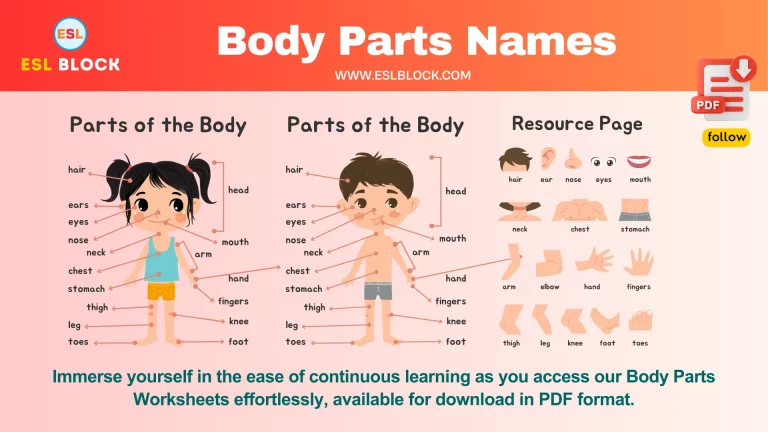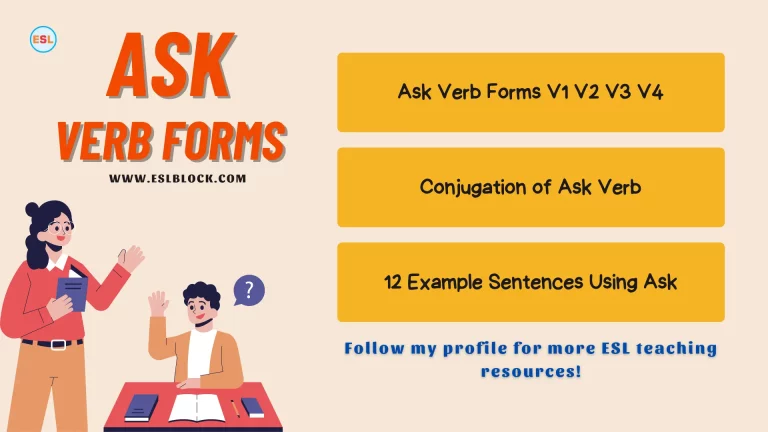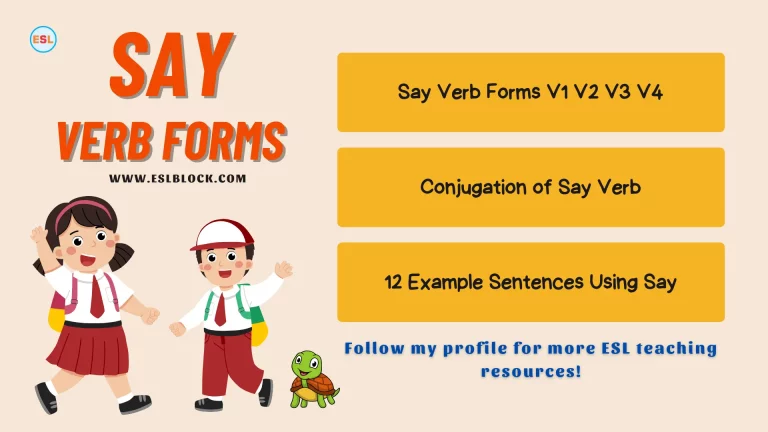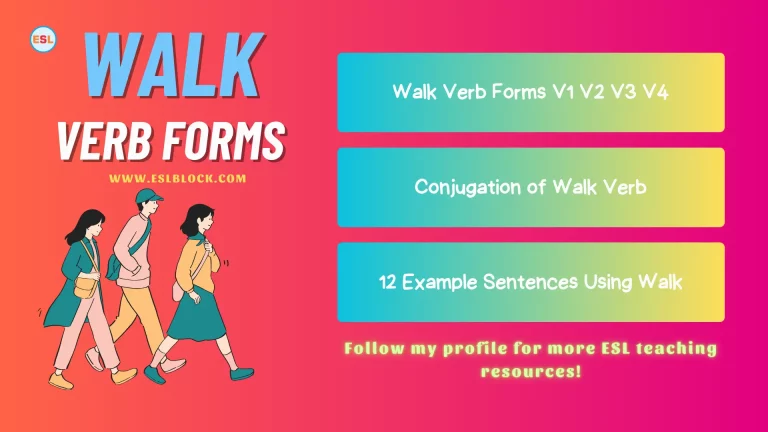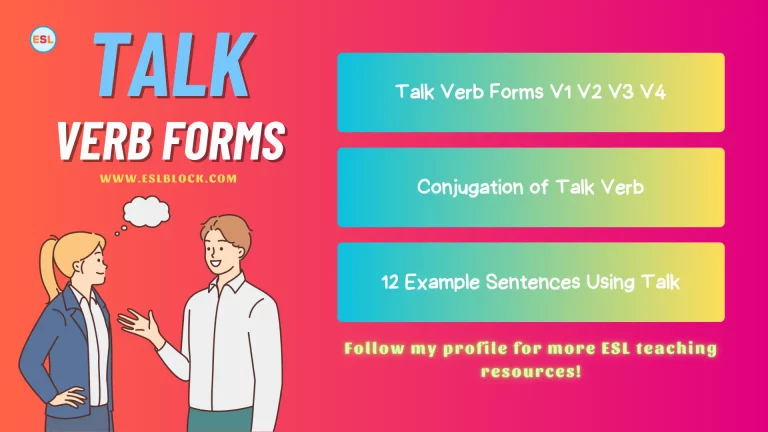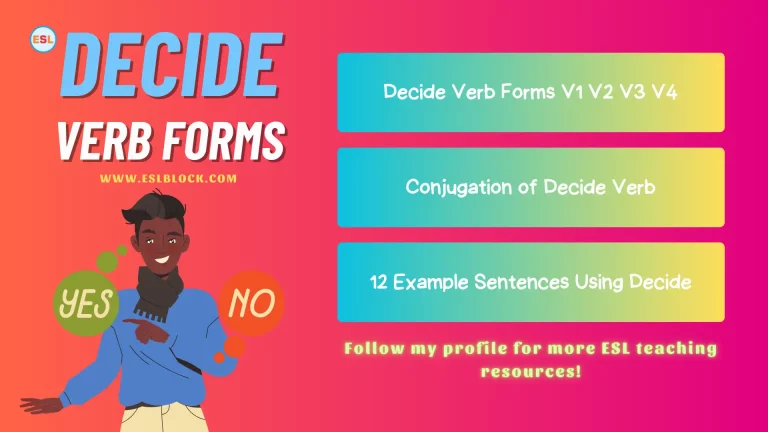Rules of Using Articles with Examples
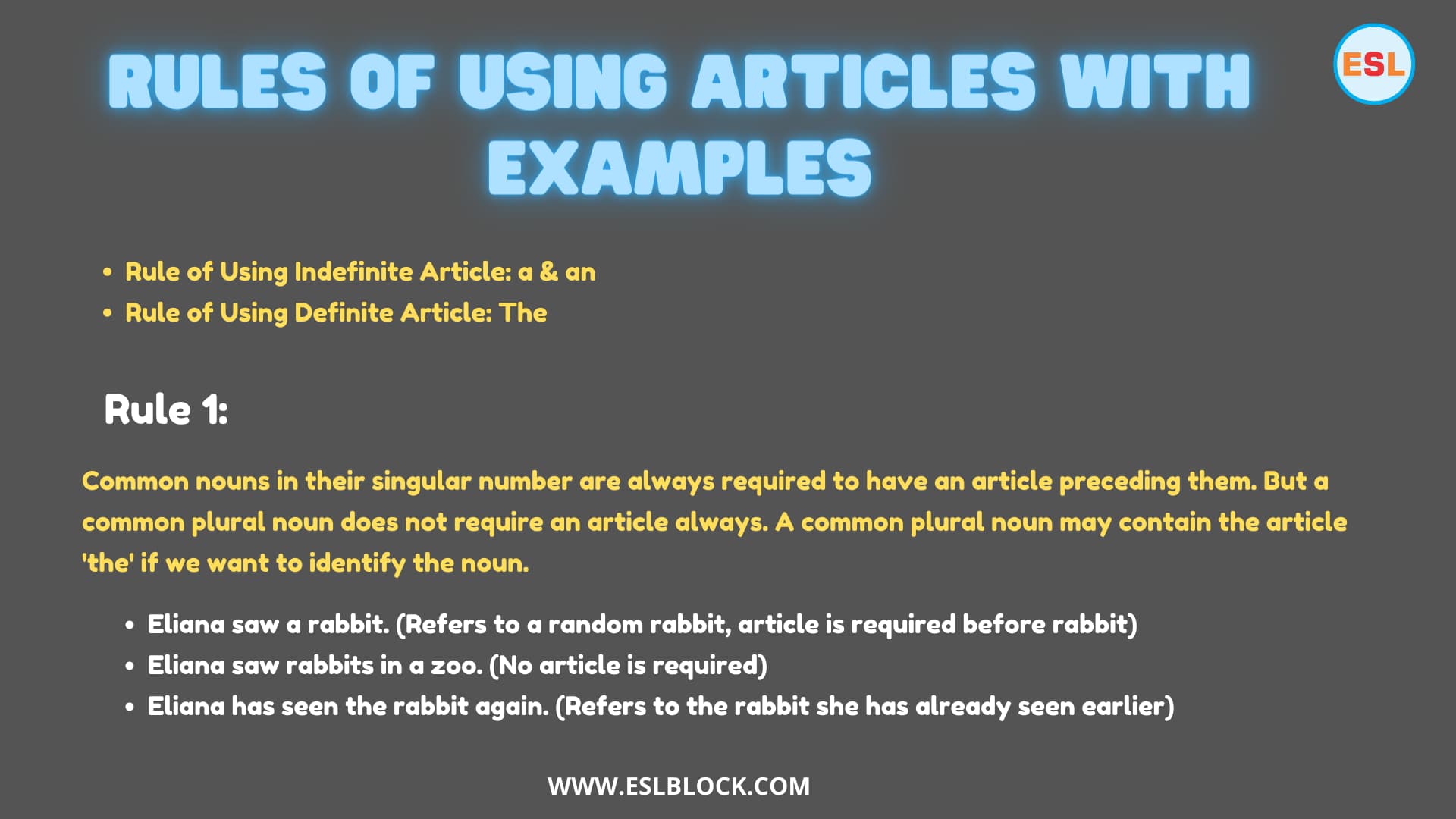
In this article, I am going to explain Rules of Using Articles with Examples. Articles are the words that define a noun as either specific or non-specific. An article is an adjective. Like adjectives, articles modify nouns. Definite article or Indefinite article, each of the articles has a lot of uses in different sentences. I have established some Rules for Using Articles with Examples. You may perform Article Quizz for more understanding.
Also read: What are Definite and Indefinite Articles in English Grammar?
Rule of Using Indefinite Article: a & an
Rule 1:
Common nouns in their singular number are always required to have an article preceding them. But a common plural noun does not require an article always. A common plural noun may contain the article ‘the’ if we want to identify the noun.
Example Sentences:
- Eliana saw a rabbit. (Refers to a random rabbit, article is required before rabbit)
- Eliana saw rabbits in a zoo. (No article is required)
- Eliana has seen the rabbit again. (Refers to the rabbit she has already seen earlier)
- Eliana has seen the rabbits again before leaving the zoo. (Refers to the particular rabbits of the zoo which she saw earlier.)
Rule 2:
The selection between the two indefinite articles – a & an – is determined by sound. Words starting with consonant sounds ‘a’ are used before the word, and words starting with vowel sounds ‘an’ are used before the word. There are some exceptional cases also.
Example Words:
- a Eurobean, a university, a union, a useful book, etc.
- a one-man army, a one-dollar note, etc.
- an LLM, an MA, a BA, an LLB, a BSC, etc.
Rule 3:
Proper nouns typically don’t require any article, but if a proper noun is required to function as a common noun, it is necessary to include either a or an in the sentence.
Example Words:
- I think I am a Shakespeare. (In this sentence, ‘Shakespeare’ does not refer to the actual person but someone like him.)
- Victoria seems to be an Australian. (‘Australia’ is a proper noun but ‘Australian’ is a common noun because there is only one specific Australia but a lot of Australians.)
Rule 4:
The indefinite articles are also used to replace the number ‘one’/’each’/’per’.
Example Sentences:
- She earned a million dollar in that auction. (One million dollar)
- We have a bike. (One bike)
- It goes 30 miles an hour. (Per Hour)
Rule 5:
The indefinite articles are generally used before adjectives.
Example Sentences:
- I have a red apple.
- She is a smart girl.
- What a nice phone!
- Lucy is a tall girl.
- Jackson is an intelligent student.
Rule 6:
The article ‘A’ sometimes comes before the determiners, for example, a little, a few, a lot of, a most, etc. on the other hand, in case of many, a or an – comes after.
Example Sentences:
- I have a few fans coming over.
- There is a little milk in the glass.
- Many a friend welcomed.
ALSO READ: Angles in a Triangle Worksheet
Rule of Using Definite Article: The
You may download Definite and indefinite articles Worksheet to enhance English writing skills.
Rule 1:
In the case of common nouns, a definite article ‘The’ is used to indicate a specific person(s) or thing(s). Generally, proper nouns do not take an article.
Example Sentences:
- The girl is running. (A particular girl)
- She saw the boy stealing. (A particular boy)
- Where is the book I gave you last day? (A specific book)
- I gave him a pen, but he lost the pen. (‘a pen’ became ‘the pen’ in the second clause because that pen was not a random pen anymore.)
Rule 2:
A definite article ‘the’ is used to generalize a group/whole class/species.
Example Sentences:
The horse is a faithful animal. (Refers to the whole species of horse.)
Rule 3:
A definite article ‘the’ is used before particular non-count noun.
Example Sentences:
- Please return the money I lent you last month.
- The water of the Arctic ocean is freezing.
Rule 4:
A definite article ‘The’ is necessory before a thing which is only one in the universe of its kind.
- The moon is brightening tonight.
- The earth is moving around the sun.
Rule 5:
Generally, using ‘the’ with geographical nouns depends on the size and plurality of the things those nouns. ‘The’ is usually used everywhere except in some cases. So, it’s better to know those anomalies first.
‘The’ must not used:
- Names of countries: America, Australia, India, Bolivia, Bahrain, England, France, Pakistan, Spain, Italy, Germany, Russia, China etc.
- Names of states, cities, or towns: Los Angeles, Islamabad, Alaska, Sydney, London, Lahore, Punjab
- Names of streets: George street, Albion Street, Old town street,
- Names of continents: Asia, Europe, Africa, Australia, South America, North America, Antarctica.
- Names of singular lakes and bays: Lake Carey, Lake Banjoosa, River Side Lake, Lake Eyre, Lake Hillier, Shark Bay, etc.
- Names of single islands: Easter Island, Bare Island, Bird Island, Fatima Island, etc.
- Names of single mountains: Mount Everest, Mount Solitary, Mount Bindo, Mount Fuji, etc.
- Names of languages: Spanish, Russian, English, (When ‘the’ precedes these nouns, they refer to the population of those languages.)
- Names of sports: baseball, long jump, cricket, football, basketball,
- Names of discipline/subject of studies: chemistry, history, biology, history, computer science, mathematics, etc.
‘The’ must used:
- Names of oceans, gulfs, seas, and rivers: the Arabian guls, the Pacific, the Atlantic, the Coral Sea, the Timor Sea, the Murray River, the Persian Gulf, the Nile, the Darling River, etc.
- Names of countries with united states or islands: the United States of America (the USA), the UK, the UAE, the Philippines, the United States of Russia etc.
- Names of great lakes: the Great Lakes, the African Great Lakes
- Names of mountain ranges: the Koh Hinu kash, the Himalayas, the Alps, the Andes, etc.
- Names of a group of Islands: the West Indies, the Andamans, etc.
Rules of Using Articles with Examples InfoGraphics
Here are some printable infographics about Rules of Using Articles with Examples. Printable infographics are a fantastic way to share a significant amount of details in a short time in a stunning way. The Rules of Using Articles with Examples infographic can help teachers and students to share their thoughts easily.
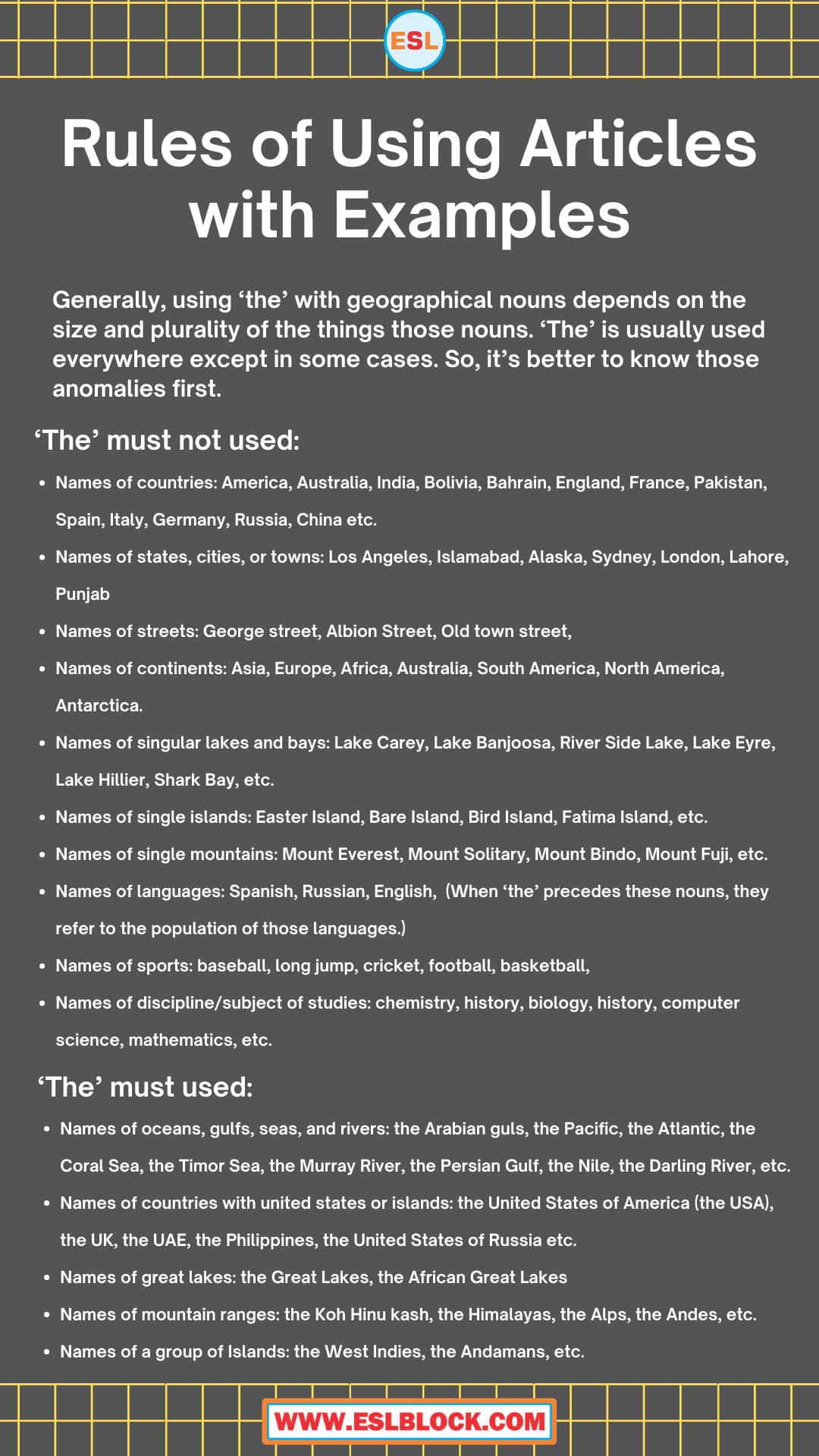
My Considerations
With this set of Rules of Using Articles with Examples, you will quickly determine whether you are making the most effective use of the Articles and how they could be used to enhance English writing skills.
Since the articles are the main part of English Grammar, the importance of developing English learning skills cannot be undervalued without Rules of Using Articles with Examples.
You can read the above sample sentences about Rules of Using Articles with Examples to improve your understanding of English grammar.
Encourage your children to learn these basic but commonly used Rules of Using Articles with Examples, by following the simple example sentences given above. Then, save this list of Article Example Sentences, handy for your kids in the future.
If you enjoyed a printable infographic about Rules of Using Articles with Examples, I’d be very thankful if you’d help it spread by emailing it to your friends or sharing it on Pinterest, Reddit, Twitter, Instagram, or Facebook. Thank you!
Also read: Adjectives That Start With Y
Recap of what we just learned
- Rule of Using Indefinite Article: a & an
- Rule of Using Definite Article: The
- Rules of Using Articles with Examples InfoGraphics
With ESLBLOCK, you will not face problems studying new ideas. If you are in doubt, about the qualities of blog posts about Rules of Using Articles with Examples, reach us through our blog’s comment section. Keep checking back! We’ll attempt to give you feedback as early as possible. Thank you!
Also read: Adjectives That Start With Z
Article Exercise Quiz
- You should take class first about Article Worksheet!
- 100 Example Sentences Using Articles A An The
- What are Definite and Indefinite Articles in English Grammar?
Related Topics
Explore the full list of Adjectives to Describe a Person from A to Z!
- A Adjectives to Describe a Person
- B Adjectives to Describe a Person
- C Adjectives to Describe a Person
- D Adjectives to Describe a Person
- E Adjectives to Describe a Person
- F Adjectives to Describe a Person
- G Adjectives to Describe a Person
- H Adjectives to Describe a Person
- I Adjectives to Describe a Person
- J Adjectives to Describe a Person
- K Adjectives to Describe a Person
- L Adjectives to Describe a Person
- M Adjectives to Describe a Person
- N Adjectives to Describe a Person
- O Adjectives to Describe a Person
- P Adjectives to Describe a Person
- Q Adjectives to Describe a Person
- R Adjectives to Describe a Person
- S Adjectives to Describe a Person
- T Adjectives to Describe a Person
- U Adjectives to Describe a Person
- V Adjectives to Describe a Person
- W Adjectives to Describe a Person
- X Adjectives to Describe a Person
- Y Adjectives to Describe a Person
- Z Adjectives to Describe a Person


